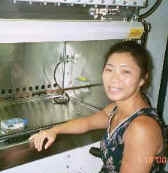
School:
Grade Level:
Teaching Position:
Supervisor:
Department:
Mentor:
Research Project Year:
Research Project Title:
Research Project Description:
The goal of Dr. Cyrus Safinya's group at UCSB's Materials Research Laboratory is to optimize the delivery of foreign DNA into the nucleus of cells in gene therapy. Gene therapy is a method of correcting genetic defects via transfection, replacing the missing or defective genes with a healthy, foreign piece of DNA into the nucleus.
There are two general methods of transfection: physical and carrier. The physical method involves directly placing the foreign DNA into the cells by injecting the DNA with a with a small needle. This method is very useful in experimental research, but not very practical for clinical purposes since it requires cells to be treated individually.
The carrier method is being investigated by Dr. Safinya's group. One way to use this method is to use a virus as the carrier to deliver the foreign DNA into cells. There are several draw backs to this method. Safinya's group is instead using synthetic chemicals as foreign DNA carriers. The synthetic chemicals are positively charged phosopholipids that when mixed with the negatively charged DNA, self-assemble into DNA-lipid complexes. This method of transfection is advantageous due to its low toxicity and non-immunogenicity. In addition, the lipid-DNA complexes are easy to produce and have no DNA size limitations. This transfection method, however, has a lower efficiency than the use of viral vectors.
To increase the transfection efficiency of these DNA-lipid complexes, the lab is divided their research into three main areas of focus: x-ray diffraction, protein assays, and imaging. My project focused on the imaging area. I followed known protocols and started to investigate a new protocol to stain cellular components to better understand the interactions between the positively charged lipid DNA complexes and the various organelles within the cell.
Curriculum Project Year:
Curriculum Project Title:
Curriculum Project Description:
Create a community of researchers in your classroom. Using the CA science standards as a guide, we'll brainstorm lab activities that mimic the methodologies of a University research facility to guide your students to a better understanding of these research skills. You will also explore how students translate these skills into their science fair projects
